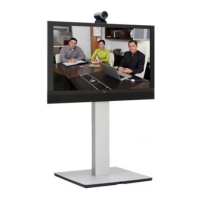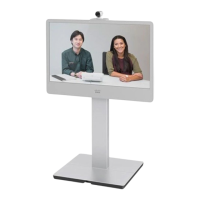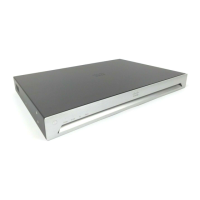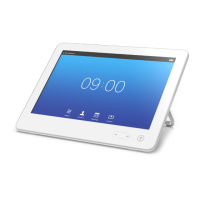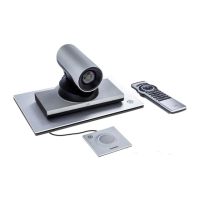D15119.02 MX700 and MX800 Administrator Guide TC7.2, AUGUST 2014. www.cisco.com — Copyright © 2014 Cisco Systems, Inc. All rights reserved.
138
Cisco TelePresence MX700 and MX800 Administrator Guide
Audio standards
• 64 kbps and 128 kbps AAC-LD, G.722, G.722.1,
G.711, G.729AB
Audio features
• High quality 20 kHz audio
• Eight separate acoustic echo cancellers
• Eight-port audio mixer
• Automatic gain control (AGC)
• Automatic noise reduction
• Active lip synchronization
Audio inputs (fifteen inputs)
• Eight microphones, 48V phantom powered,
Euroblock connector, each with separate echo
cancellers and noise reduction; all microphones can
be set for balanced line level
• Four balanced line level inputs, Euroblock connector
• Three HDMI inputs, digital, stereo (from PC/DVD)
Audio outputs (eight outputs)
• Six balanced line level outputs, Euroblock connector
• Two HDMI outputs (MX700: Both HDMI audio outputs
are used for the two integrated screens. MX800: One
HDMI audio output is used for the integrated screen)
Dual stream
• H.239 (H.323) dual stream
• BFCP (SIP) dual stream
• Support for resolutions up to 1080p30, independent
of main stream resolution
Multipoint support
• Five-way embedded SIP/H.323 MultiPoint, ref.
MultiSite
• Cisco Ad-Hoc Conferencing (requires Cisco
Unified Communications Manager (CUCM), Cisco
TelePresence Server and Conductor)
• Cisco Conferencing Active Control
MultiSite features
(embedded multipoint)
•
Five-way 720p30, three-way and four-way 1080p30
• Full individual audio and video transcoding
• Individual layouts in MultiSite continuous presence
• H.323/SIP/VoIP in the same conference
• Support for Presentation (H.239/BFCP) from any
participant at resolutions up to 1080p15
• H.264, encryption and dual stream from any site
• IP downspeeding
• Dial in and dial out
• Conference rates up to 10 Mbps
Protocols
• H.323
• SIP
• Single call stack support, either H.323 or SIP
registration
• ISDN (requires Cisco TelePresence ISDN Link)
Embedded encryption
• H.323 and SIP point-to-point and MultiSite
• Standards-based: H.235 v3 and Advanced
Encryption Standard (AES)
• Automatic key generation and exchange
• Supported in dual stream
IP network features
• DNS lookup for service configuration
• Differentiated services (QoS)
• IP adaptive bandwidth management (including flow
control)
• Auto gatekeeper discovery
• Dynamic playout and lip-sync buffering
• H.245 DTMF tones in H.323
• RFC 4733 DTMF tones in SIP
• Date and time support via NTP
• Packet loss based downspeeding
• URI dialing
• TCP/IP
• DHCP (Dynamic Host Configuration Protocol)
• IEEE 802.1x network authentication
• IEEE 802.1q VLAN
• IEEE 802.1p QoS and class of service
• ClearPath
• Medianet: Mediatrace and Metadata
IPv6 network support
• Dual-stack IPv4 and IPv6 for DHCP, SSH, HTTP,
HTTPS, DNS and DiffServ
• Support for static IP address assignment, stateless
autoconfiguration and DHCPv6
Cisco Unified Communications Manager
(requires Cisco UCM version 8.6 or later)
• Native registration with Cisco Unified
Communications Manager (CUCM)
• Basic CUCM provisioning
• Firmware upgrade from CUCM
• Cisco Discovery Protocol and DHCP option 150
support
• Basic telephony features such as hold, resume,
transfer, and corporate directory lookup
Security features
• Management using HTTPS and SSH
• IP administration password
• Administration menu password
• Disable IP services
• Network settings protection
Network interfaces
• One LAN/Ethernet (RJ-45) 10/100/1000Mbps
• Two LAN/Ethernet (RJ-45) interfaces to be used for
Cisco TelePresence peripherals
Other interfaces
• Two USB host for future use
• GPIO
All specifications are subject to change without notice, system specifics may vary.
All images in these materials are for representational purposes only, actual products may differ.
Cisco and the Cisco Logo are trademarks of Cisco Systems, Inc. and/or its affiliates in the U.S. and other
countries. A listing of Cisco’s trademarks can be found at www.cisco.com/go/trademarks. Third party trademarks
mentioned are the property of their respective owners. The use of the word partner does not imply a partnership
relationship between Cisco and any other company.
July 2014
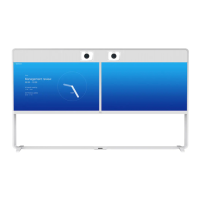
